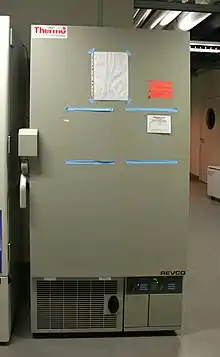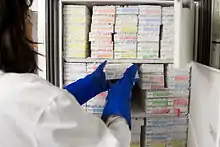ULT freezer
An ultra low temperature (ULT) freezer is a refrigerator that stores contents at between −40 to −86 °C (−40 to −123 °F).[1] An ultra low temperature freezer is commonly referred to as a "minus 80 freezer" or a "negative 80 freezer", referring to the most common temperature standard.[2] ULT freezers come in upright and chest freezer formats.

Application

In contrast to short term sample storage at +4 to −20 °C (39 to −4 °F) by using standard refrigerators or freezers, many molecular biology or life science laboratories may need long-term storage (including "cold chain" and/or "colder chain" infrastructures) for biological samples like DNA, RNA, proteins, cell extracts, or reagents. To reduce the risk of sample damage, these types of samples need extremely low temperatures of −80 to −86 °C (−112 to −123 °F). Cells are stored in tanks of liquid nitrogen at −196 °C (−320.8 °F). Cryogenic chest freezers can achieve temperatures down to −150 °C (−238 °F), and may include a liquid nitrogen backup.
Samples in ULT freezers are often stored in polymer tubes or microtubes. Typically 64, 81 or 100 of these microtubes are placed in a grid in a cardboard or polymer box. Standard ULT freezers can store around 350 to 450 boxes of microtubes.
.jpg.webp)
Outside of life science, tuna fishing requires the use of ULT freezer.
ULT freezers are commonly fitted with alarm systems that will remotely alert designated parties in the case of a freezer failure.
Pull down time
The pull down time is defined as the necessary time to cool down the ULT freezer from ambient temperatures to the selected temperature of −80 to −86 °C (−112 to −123 °F). The time strongly depends on the type of insulation, the efficiency of the compressor system as well as the installed metal shelves within the freezer. At the start of the twenty-first century, ULT freezers were able to cool down within 3 to 5 hours. Warm up time is typically 1/8 °C per minute.
Energy consumption
Due to the low temperature, ULT freezer consume high amounts of electric energy[3] and hence are expensive to operate. In 2010, Stanford University had more than 2,000 ULT freezers, which used an estimated 40 billion BTUs of energy and cost the university $5.6 million annually. Newer ULT freezers consume less energy.[4]
In recent years, some scientists have began suggesting that laboratories set freezers to –70 °C instead of –80 °C to conserve energy and decrease wear on the freezer's compressor.[5][6]
Depending on the volume of the freezer, the opening frequency of the users as well as the number of samples, the energy consumption starts from ca. 11 kWh/day and higher. To reduce the energy consumption, the insulation should be as efficient as possible. Additional inner doors reduce the loss of temperature when opening the main door. Icing within the ULT freezer should be reduced to a minimum. Modern ULT freezers employ variable speed drives for both the compressors and fans. This has reduced energy consumption a further 30% to typically 8.5 kWh/day.
Refrigeration cycle
ULT freezers that employ the cascade refrigeration (CR) system use up to 20 times the energy footprint of household fridges, and used to refrigerate with greenhouse gas fluids (typically hydrofluorocarbon R-508B).[3] Modern ULT freezers employ HC (i.e. hydrocarbon) gas mixtures: typically, ethane and propane. This has also improved their efficiency by up to 30% over the conventional CFC or HFC gassed freezers.
_process_schematic_diagram.png.webp)
See also
References
- Gumapas, Leo Angelo M.; Simons, Glenn (2013). "Factors affecting the performance, energy consumption, and carbon footprint for ultra low temperature freezers: Case study at the National Institutes of Health". World Review of Science, Technology and Sustainable Development. 10: 129. doi:10.1504/WRSTSD.2013.050786.
- "Ultra-Low Temperature Freezer Program | Penn Sustainability". www.sustainability.upenn.edu. Retrieved 11 November 2020.
- Berchowitz, David; Kwon, Yongrak (2012). "Environmental Profiles of Stirling-Cooled and Cascade-Cooled Ultra-Low Temperature Freezers". Sustainability. 4 (11): 2838–2851. doi:10.3390/su4112838.
- Dickey, Gwyneth (2 June 2010). "Freezer Retirement Program: Out with the cold, in with the new". Stanford University. Retrieved 11 November 2020.
- "To find hacks for greening your lab, start with the freezer". Chemical & Engineering News. Retrieved 11 November 2020.
- "Cold Storage". Green Labs: MIT. Retrieved 11 November 2020.